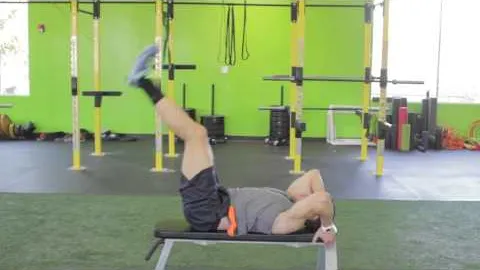
If you're looking for an exercise that targets your abdominal muscles, hip flexors, and glutes all in one go, the Lying Leg Raise with Hip Thrust is the perfect choice. By combining the leg raise with the hip thrust, you can effectively strengthen and tone these muscles. In this article, we will break down the proper technique, benefits, modifications, and precautions for this highly effective exercise.
The Lying Leg Raise with Hip Thrust offers a plethora of benefits for both beginners and seasoned fitness enthusiasts. Some of the key benefits include:
Core Strengthening: This exercise primarily targets the abdominal muscles, especially the lower abs. The leg raise engages the rectus abdominis, transverse abdominis, and internal and external obliques.
Hip Flexor Activation: The hip flexors play a crucial role in many daily activities, such as walking, running, and sitting. The leg raise motion activates the hip flexors, improving their strength and flexibility.
Glute Activation: By combining the leg raise with the hip thrust, you engage the gluteal muscles, including the gluteus maximus, gluteus medius, and gluteus minimus. This leads to stronger and firmer glutes.
Lower Back Strengthening: When performed correctly, this exercise can strengthen the muscles in your lower back, helping to alleviate lower back pain and improving posture.
Follow these step-by-step instructions to perform the Lying Leg Raise with Hip Thrust:
Starting Position: Lie flat on your back on an exercise mat. Keep your legs straight, feet together, and arms extended along your sides with palms facing down.
Leg Raise: Lift both legs off the ground while keeping them straight. Slowly raise your legs to a 90-degree angle or as close as you can comfortably go.
Hip Thrust: Once your legs are raised, engage your glutes and push your hips up towards the ceiling. Your body should be in a straight line from your shoulders to your knees.
Lowering Phase: Slowly lower your legs back down to the starting position while maintaining control and keeping your core engaged.
Repeat: Repeat the leg raise and hip thrust sequence for the desired number of repetitions.
If you're new to this exercise, it's essential to start with modifications to avoid strain or injury. Here are a few modifications and progressions you can incorporate:
Bent Knee Leg Raise: If you find it challenging to keep your legs straight during the leg raise, try bending your knees slightly. This modification reduces the lever arm and makes the exercise easier.
Single Leg Raise: Once you've mastered the basic movement, you can progress to a single-leg raise. Lift one leg off the ground while keeping the other leg straight and hovering slightly above the mat.
Resistance Band: To increase the intensity, you can add a resistance band around your thighs. This provides additional resistance throughout the exercise, making it more challenging for your muscles.
To stay safe while performing the Lying Leg Raise with Hip Thrust, keep the following precautions and tips in mind:
Maintain Proper Form: It's crucial to maintain proper form throughout the exercise to avoid straining your lower back or neck. Focus on engaging your core and keeping your movements controlled.
Start Slowly: If you're new to this exercise, start with a few repetitions and gradually increase them over time. This helps your muscles adapt and reduces the risk of injury.
Listen to Your Body: If you experience any pain or discomfort, stop the exercise immediately. Consult with a fitness professional if you have any pre-existing injuries or conditions that may affect your ability to perform this exercise safely.
Warm-up and Cool-down: Always warm up your body with light cardio exercises before attempting this exercise. Additionally, finish your workout with a cool-down and stretching routine to prevent muscle soreness.
The Lying Leg Raise with Hip Thrust is a highly effective exercise that offers numerous benefits for your core, hips, and glutes. By following the proper technique, incorporating modifications and progressions, and taking necessary precautions, you can safely and effectively strengthen and tone these muscle groups. Incorporate this exercise into your fitness routine for a healthier, stronger, and more balanced body.
If you're looking for a gym, fitness club or yoga studio, you've come to the right place.
You can find information about gyms in your area. Browse catalog of gyms and find gyms with classes which are you looking for.
On gym page you can find simple information like address, phone or website. You can find list of available classes. You can check availability of personal training or small group classes. On place page you can also see information about open hours.
You can find gyms near you with amenities, courts, studios and equipments.
Use our map to find gym at your city or district.
In Gym Navigator you can find list of exercises with movies for many body parts.
You can browse exercises catalog and find exercises the best of you.
You can also find exercises grouped into workout plans, which you can use to improve you body. Each routine show you exercises one by one and give you possibility to count you progress and count down rest time.